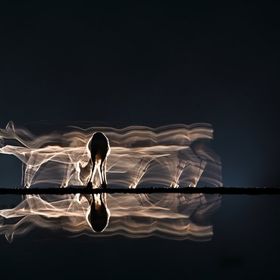Young male leopard passes trough still guards its territory. Dry grass and savanna is beautifully yellowish during the dry season. Leopard (Panthera pardus) - O...
Read more
Young male leopard passes trough still guards its territory. Dry grass and savanna is beautifully yellowish during the dry season. Leopard (Panthera pardus) - Okavango delta.
Read less
Read less
Views
300
Likes
Awards
Contest Finalist in Covers Photo Contest Volume10
Contest Finalist in Social Exposure Photo Contest Vol 26
Peer Award
Absolute Masterpiece
Top Choice
Magnificent Capture
Superb Composition
Genius
All Star
Top Ranks
Categories
Same photographer See allBehind The Lens
Discover more photos See all
Behind The Lens
Location
I created this photo during my expedition to Africa. I took a great opportunity to take a picture of a wild leopard in the natural habitat of a bush that was just controlling its territory.Time
It was the morning of November 21 at 7:30 a.m.Lighting
There was a continuous thin cloud that gave the scene a soft diffuse light. Therefore on the fur and on the grass are no highlights and there are no significant shadows on the leopard's bodies.Equipment
I worked with my favourite very fast digital camera Nikon D5 and with my zoom lens Nikkor 200-500 f/5,6. I worked handheld without a tripod, from safari car.Inspiration
I love nature and especially wild animals. Visiting Africa has been my dream since childhood. I wanted to see with my own eyes in the wild animals that I often saw in documentaries.Editing
I love natural photos. Shots without big adjustments. I try to capture all my photos so I do not have to use the post-processing. I know it is very modern and trendy today, but I do not work with PS or LR or other sophisticated post-processing software. I invoke my NEF only in Nikon View and Nikon Capture and make only minor edits. Maybe my photos could be even more attractive, but I want to show real reality.In my camera bag
The contents of my robust Tamrac bag is primarily a powerful digital camera that I can rely on in every weather. Now I'm normally using the body Nikon D5 and the backup body Nikon D850. I normally wear Nikkor lenses 24-70 f/2.8 and 70-200 f/2.8. These "workers" have always been with me. On the "macro" action I take the excellent old micro lens Nikkor 200 f/4 or micro lens 105 f/2,8. For animals and birds photography I need to pack "heavier weight" - I'm using the lens Nikkor 400 f/2.8 and now also a new zoom lens Nikkor 180-400 f/4. The last one year I test the new mirrorless Nikon Z7 with my fast lenses.Feedback
When it comes to photographing the endangered animal species, I recommend the form of "assisted (arranged) photography". It's about photographing a species of wild animal that is in human care. The animal is tame, working well with it, and it is especially safe for humans. Most importantly, the photographer does not disturb wild animals in their natural biotope. Today there is a trend commercial group photographic expeditions to exotic countries. From the yield is funded the rescue of endangered animal species. But too frequent visits of groups of people in animal biotopes are very disturbing and stressful for endangered animals and their food chain. These expeditions can become very destructive for small animal populations and, instead of rescuing animals, can speed their extinction. We all photographers have to think, whether our money really helps those animals.














































